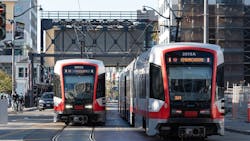SMFTA to upgrade Muni Metro
The San Francisco Municipal Transportation Agency (SFMTA) is upgrading Muni Metro, its light-rail system. Upgrades will replace the current train control system in the subway and extend the modern system to street-level SFMTA operation for faster, more reliable service.
Current ATCS limitations
SFMTA notes that despite being the third busiest light-rail system in the U.S., Muni Metro is the last to funnel five lines onto one path under Market Street.
The agency says its current automatic train control system (ATCS) has many challenges. The ATCS provides much greater safety and reliability than manual operation, but it runs on 1980s technology and can experience equipment failures that cause delays, impacting riders’ commutes to work, school, appointments and other destinations.
In October 2023, the computers that run the system crashed, automatically halting all service in the Muni Metro subway. SFMTA staff immediately responded by rebooting the system and safely guiding train operators through the subway in manual mode. Within about an hour, SFMTA says the computers were back online, vehicles returned to automatic train control and subway service returned to normal. Bus shuttles were sent to provide service between West Portal and Embarcadero stations, Church Street and Duboce Avenue during the closure.
Modernizing Muni Metro: Train Control Upgrade Project
According to SFMTA, the train control system needs to be modernized to a state-of-the-art Communication-Based Train Control (CBTC) system. CBTC uses the latest technology to:
- Maintain constant communication with all trains in the rail network from the moment they go into service, both in the subway and on the street.
- Communicate with and help prioritize signals, as the CBTC system will tell signals a train is coming well in advance.
- Automatically push software updates to keep the system current
- Keep trains evenly spaced to prevent bunching and gaps for more consistent wait times and travel times that match the advertised frequency and make trip planning more reliable, among many other benefits.
CBTC is expected to reduce SFMTA delays by 20 to 25 percent, on top of the reductions the agency has already achieved, which will allow SFMTA to run more trains throughout the entire Muni Metro network, making travel faster and more efficient. SFMTA has already started building out the pilot phase of the new system by 2025.
Fix It Weeks help maximize Muni Metro
SFMTA says Fix It Week, which runs once a quarter, is one example of its success reducing long Muni Metro delays by about 70 percent compared to 2019. The agency says that prior to launching Fix It Week, maintenance windows were short and it was difficult for crews to complete work efficiently, leading to ongoing maintenance challenges because Metro maintenance can only take place when service is not running.
By closing the Muni Metro early for a few days every few months during the quarterly Fix It Week, SFMTA says its Maintenance of Way (MOW) teams can optimize work time for critical maintenance, preventing potential breakdowns. During Fix It Week, maintenance crews have an extended window to perform underground infrastructure improvement work that cannot be completed during the usual overnight windows.
SFMTA notes the goal of Fix It Week is to make Muni Metro subway operations more reliable, ensure safety and improve the customer experience. Nine MOW teams (Track, Cable Car, Motive Power, Maintenance Engineering, Mechanical Systems, Overhead Lines, Underground, Paint Shop and Signal) are involved in the maintenance work, including custodial staff cleaning Muni Metro stations.
Buses provide substitute service for Muni Metro during Fix It Week and connects all stops on Market Street. Muni Metro ambassadors help riders navigate to their destination at the busy transfer stops.
